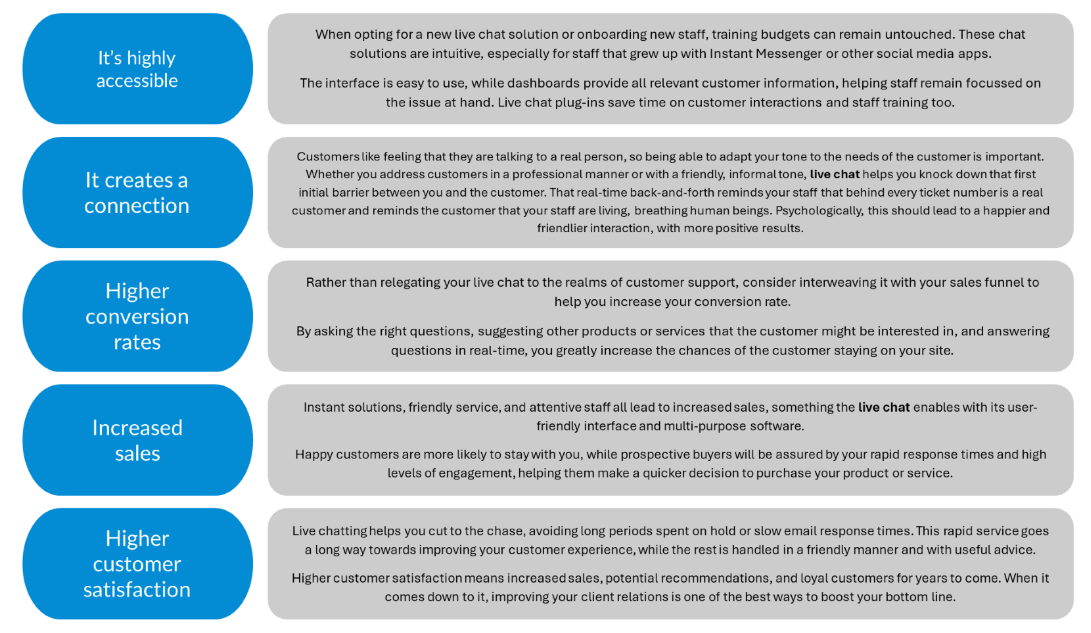Today’s customers want information right away, and they prefer not to pick up the phone to get it. Live chat is a great way to ensure your customers have everything they need with no delay so you can offer a great customer experience.
This powerful customer messaging software tool puts assistance and information at customers’ fingertips. They’ll simply write in the chat window on their screen and receive an answer in real-time from your customer service agents, reducing the need for emails and phone calls.
In a competitive online world, these rapid responses can help differentiate you from others in your industry. Being able to respond to your customer’s doubts and questions allows you to offer better service and, ultimately, close more sales.
The evolution of live chatting has made customer service operations more efficient, less time-consuming, and less stressful for all involved. It is a technology that is intuitively easy to use and helps companies build positive relationships with their customers.
From customer support to sales, live chat works across a whole variety of industries to enhance the customer experience and improve productivity. As well as offering quick solutions to support customers with issues, it helps generate leads and convert website visitors.
Let’s dive into how this works and the benefits it brings to businesses catering to today’s consumers and their expectations of high engagement and immediate information.
How does live chat work?
Live chat software is essentially a messaging management system that plugs into any website to streamline customer support. Live chat support gives visitors an easy way to get answers and solutions to product and service-related issues without leaving the webpage.
The software queues and prioritises customer inquiries, which can be assigned to specialist representatives depending on the nature of assistance required. It also gives businesses a whole variety of advanced features to make the most of customer interactions.
A no-download solution
Live chat software is installed on the website so visitors can use the function on any device. They don’t have to download any apps to use it, nor do they have to log in or register. However, customers logged into their accounts often enjoy personalized treatment from a system that recognise them.
Simple to use
The live chat function on a website is usually a window with a chat box that appears on the bottom right of the web page. Website visitors can initiate a chat by clicking a link to open a live chat window, or the chat panel can offer visitors assistance before they have to ask, alerting the visitor with sounds or messages.
Easy information for customer service agents
Live chat tools empower your customer service teams to work more efficiently, with a plethora of information about the visitor displayed on a dashboard eliminating the need to ask repetitive questions.
This dashboard lets agents see information gathered by website cookies, which can include the visitor’s country, time zone, and local language, plus information about their specific issue.
The live chat support window can also be programmed to ask the visitor questions about the nature of their issue before connecting them to the most appropriate agent.
Agents can also pull up customer information from previous interactions recorded in a database so they have the best information available to manage the situation.
How can you use live chat?
Live chat is an evolved help desk that offers much more than basic support. The interface for website visitors is similar to chat messaging on social media platforms, with the ability to display text, emojis, images, videos, and links, as well as share attachments.
Here are some of the ways businesses can use live chat to enhance the customer experience and achieve more positive results from online customer interactions.
Real-time customer support
A strong alternative to emails and phone calls, live chat support has become the preferred way customers seek help for issues they encounter with products and services.
With a response time that’s typically less than three minutes, giving personalised assistance brings a higher degree of customer satisfaction. Compared to keeping customers waiting for email replies or for someone to pick up the phone, these rapid responses win every time.
A proactive sales solution
Alongside customer support, live chat doubles as a sales channel to introduce visitors to products and services they might be interested in. Representatives can answer questions on the fly, help customers with their decision-making and seal deals in real-time.
Honest customer feedback
As a measure of customer satisfaction, collecting customer feedback is one of the best ways to improve your business. This insight is most valuable when you ask for reviews immediately after the chat has ended, when memories are fresh, and the customer feels more invested in helping you improve.
Why customers prefer live chat
Research shows that live chat interactions result in more than 70 percent customer satisfaction, compared to just over 60 percent for emails and about 40 percent for phone interactions. Here’s why:



How to use live chat effectively
With a live chat dashboard to monitor customer interactions in real-time, support team managers can ensure an optimum user experience for customers and staff by managing the volume and response times of incoming chats.
Customers get a seamless experience, with their issues correctly assigned and evenly distributed among the available support staff, while staff have all the information they need to provide great service.
Here are some best practices customer service agents can use to ensure live chat experiences are positive and build a relationship with the customer:
Control the conversation:
- Clarify the issue the customer wants to resolve and keep the conversation on track with the issue at hand.
- If a customer has to wait while their issue is being investigated, keep them informed of progress with regular updates or messages thanking them for their patience.
- Keep customers calm by letting them know how long they can expect to wait to connect with a human assistant or to have their issue resolved.
Give speedy responses:
- Have pre-prepared responses ready to quickly post replies to common customer questions without having to type them out each time. These are also handy for handling abuse with carefully written responses to calm unsavoury situations.
- Build a knowledge base of customer issues and solutions. Make it accessible to all live chat staff so they can resolve issues without having to transfer the chat to another representative or keep the customer waiting too long.
Keep it simple:
- Keep language simple and conversational. Customers want solutions as quickly as possible, they don’t need formality. Whenever possible, ask visitors short and concise questions that require a short yes-or-no answer to get to the root of their issue.
Reduce dependency on customer support:
- When customers need help resolving a simple issue, use the opportunity to teach them how to avoid experiencing the same issue again.
Live chat vs chatbots
Live chat puts website visitors in touch with real humans in real-time. A chatbot uses artificial intelligence to do the same job as a human customer service representative. They offer several advantages over live chat and can be a cost-effective solution to taking your customer service to the next level.
Advantages of chatbots
Chatbots don’t need breaks, translators, or sleep, and they aren’t bothered by time zones either. They work 24/7 to provide assistance, meaning that your customers can get their answers at any time of day (or night).
A lot of questions asked by customers are repetitive, meaning there’s little point in handing the task to a human agent. These simple queries can be resolved immediately, eliminating the potential for human error.
Chatbots can handle sudden increases in support requests too. While live agents are limited to one customer, or several at most, chatbots can process countless queries at any given time.
The future of customer service
With an influx of new technologies and an audience with changing demands, the customer service landscape is rapidly changing. Live chat bots can help your business cut costs, improve customer service and increase sales with a friendly interface and rapid responses.
These stronger relationships with your customers help you continually improve your services, increasing leads and optimising your conversion rates. Whether you opt for live agents or chatbot software, you’ll save time and money, increasing your bottom line.
